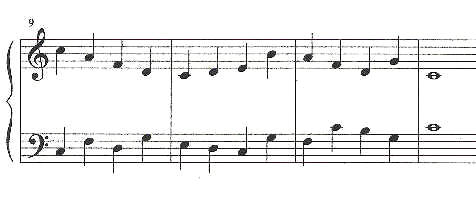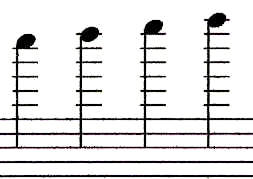|
Looks Like it
Sounds--
or, those bizarre squiggles we call music.
(part one)
Why do we
write music the way we do and is it actually the
best method? Dare we ask?
part two
part three
|
When the ancients
wanted to refer to the sun, they simply drew a
picture of it.
|
 |
This is a far cry from writing a
combination of squiggles and lines, as we do today. The
word SUN doesn't actually look like the sun; we wouldn't
know that it had anything to do with the sun at all
unless we were told. Each of the letters represents a
specific sound, but that still doesn't mean when you add
them up they are going to automatically suggest
anything.
|
SUN
|
These two very
different approaches to language have their
obvious strengths and inevitable weaknesses.
There is something lost in not being able to
graphically represent what you are talking
about. Clearly a language like that is much
harder to learn, endless combinations of
arbitrary lines and curves with their numerous
rules for organization, chances for
misspellings, bad grammar, and the like make for
some of that celebrated "modern anxiety." And
you don't get to admire the pictures.
|
| I'd like to
see you try, however, to represent something
like "inevitability" with a picture.
Wait, I just thought of one. How about a guy who
has just stepped off a cliff? The only problem
there is that pretty soon they'll also be using
that one for the word "gravity", maybe the word
"panic" and eventually, "lawsuit", given the
various needs of our contemporary society. So
the simple one-to-one relationship between a
thought and its picture will get spoiled anyway.
Leave it to us "moderns" to ruin that fun.
|

"Inevitability"
|
The charm of a
pictorial language like hieroglyphics is that
everything that needs to be communicated can be
represented graphically, and means exactly what
it looks like. None of this "except after g" or
"sometimes y" stuff we have to remember today.
The sun means only one thing, not something else
if you draw a picture of a polar bear after it.
Once complexity (or abstraction) rears its (for
some) ugly head, you have to start looking for
context and overall meaning and you still might
not get it right away.
|
The word
"phonetically" means "how it sounds" or, to
spell a word using letters that obviously make
the sounds of the word. But, as is often
pointed out, the word "phonetically" itself,
isn't. If it was, it would be spelled
"fonetikalee".
In a
pictorial language, putting a polar bear next
to the sun could mean the bear was sunning
himself, or trying to eat the sun, or running
after the sun, but it would not mean, say,
swimming pool. Each character, both the sun
and the bear, are still suns and bears,
regardless of their relationship to each
other. You don't add two characters together
and they become something totally different.
But, for some reason, in modern English, you
put an H next to a P and they cancel each
other and become an F! How does that make any
sense?
|
Not that modern language has completely
lost its pictorial element. We still use metaphors and
figures of speech that present a strong mental image
that creatively crystallizes abstract meaning. If we
say, for instance, that somebody is "out in left field"
we have caused the mind of the listener to glow with an
image that seems to fill in the need for a sense of
being able to 'see' what we are talking about. When we
refer to somebody whose views or behavior is a long way
from normal or from what we agree with, if we mentally
paint that picture, it gives our meaning additional
life, punch, or clarity.
Written music began life as a kind of
pictorial language--then things started to get rather
complicated.
| When, in the
ninth century, a fellow named Guido managed to
devise a system for actually writing music
down--you can read about that interesting story
elsewhere
on this website--the
method he came up with was pretty simple. Put a
line on a page. Now put a blob on the page
representing a note. If the note is above the
line it is higher than if it is on the line,
still higher than if the pitch is below the
line. High notes mean higher on the page.
Actually, what we really mean by high notes is
that they are vibrating more times per
second--sound is vibrating air, after all--but
people have always referred to high notes and
low notes as a matter of course (it takes more
effort to pop off a 'high' note because your
voice box has to flutter faster), and when you
go for a high note, people are much more likely
to gaze up at the ceiling than they are to look
at the floor. Besides, they didn't have
scientists to tell them all this when Guido was
around. |

the Guidonian hand
(a method for learning the
notes)
|
Imagine. It took nine centuries into
the "modern era" to come up with something that simple.
And there were untold centuries before that too, of
course. Several millennia for humans (Western Europeans,
anyway) to figure out how to write down something they
could already do aurally, even while they could
write--only a few of them, of course--in their own
native languages.
I remember being taught in school that
the origin of writing things down probably began as a
result of the need to keep written records of things
like taxes and what not. The real important stuff like
how much the king had in his royal treasury. Music
didn't turn a profit then anymore than it does now (ok,
I'm splitting hairs; I'm leaving aside the bulk of our
commercially successful but artistically thin
recordings) and it does not seem to have been of much
concern to anyone that it be preserved for posterity or
even so it could be shared with anybody who wasn't the
king of that immediate area.
Well, I'm oversimplifying. A lot. But
the fact remains that music was not written down for a
while in western cultures--at least that we are aware
of. There are some fragments of ancient Greek music--one
famed specimen is chiseled into a rock and is called the
"Hymn to Apollo." I've seen it. There do seem to be some
musical instructions, but these are mostly circles and
triangles and other shapes above the words which give us
no idea of what the music was supposed to sound like.
But the beauty of Guido's system is
that once a one-note to one
position-on-the-system-of-lines can be established, you
can sing anything, whether you've heard it before or
not. C is C. Or, as Guido would have thought of it, Ut
is Ut. Good thing somebody came up with a replacement
name for Ut.
Systems do have a way of becoming
unpleasantly obsolete, however. As always, some things
happened to music that Guido would never have thought
of, and in some ways his system proved to be
surprisingly adaptive and to hold up well even after so
many later changes, and in others, the system was
strained almost to the breaking point.
When Guido came up with his system, it
was the human voice, that oldest of musical instruments,
that was being taken into account. He didn't have a
piano with a range of eighty-eight notes to worry about.
Most people can't sing more than an octave or so, maybe
two, unless they are trained singers. The church music
of the time did not jump around very much, and mainly
confined itself to an octave. Eight notes. So having
four lines, and three spaces in between the lines seemed
like plenty (the space above the top line being
available for emergencies!).
______________
______________
______________
______________
It later turned out not to be. No
problem. A fifth line was added to the staff (which is
what we call that flock of lines) and now there is room
for nine notes, which is a little bit short of 88 if you
are scoring at home.
______________
______________
______________
______________
______________
There are ways to get around this
difficulty. One of which is to simply add staffs
together. Once you yoke two of your systems together,
you suddenly have space for around 19 notes. Now we are
getting somewhere.
______________
______________
______________
______________
______________
______________
______________
______________
______________
______________
Of course, in order to avoid eye-strain
from having to determine exactly which line that a note
is on--of the ten that seem to be run together-- we're
going to actually create a little break right in the
middle. Space is a nice way to clarify things. Besides,
I dare you to decide, at a moment's notice, whether a
note is on line 6 from the bottom or 7 from the bottom.
So let's split things up for clarity's sake.
______________
______________
______________
______________
______________
______________
______________
______________
______________
______________
Technically, the two staves are one
continuous system, and there is room for one
invisible line between them. This, added to the
spaces immediately above that line and below it, give us
room for three notes that are actually between the two
staves. We don't use this line unless we need it to put
a note on, and that means that unlike the others, which
run continuously whether we need them for reference or
not, this one only pops up when needed, lasts a little
over the length of the note itself, and disappears. It
is like the volunteer firefighter of notes.
 |
In
actual practice, the two staves are separated
by additional space for ease of reading, and
so that we can jam several other kinds of
musical instructions in there! (or lyrics) The
two notes at the end are actually the same
note--both the additional line extending above
the bottom staff and the additional line
extending below the top staff are known as
"middle c" and the next note above or below
them falls on the space adjacent to the first
line of the other staff. So I suppose all that
space you think you see between the staves
doesn't really exist! I mean, if you're into
quantum physics and whatnot.
|
This little line of ours in turn
creates a new kind of being which we call a ledger line.
If we can extend the staff toward the middle, why not
above and below? And why stop at one? Ledger, or
additional, lines can be added to the bottom of the
lower staff, and the top of the upper staff to extend
the number of notes we can call into being. They behave
exactly like the one in the middle, and only show
themselves when necessary. However, a good many
composers have determined to abuse a good thing when
they have it, and frequently use four, five, or six
ledger lines with impunity. You are now perceiving that
this may make things a bit hard to read. Trained
musicians, having long become accustomed to the system
of five lines and four spaces, can instantly read a note
based on its location, just like you know what four plus
four is without having to stop and consider the issue
(let us hope)--but extending too many lines in one
direction or another makes things too confusing, and
besides, there is a better method. It is called 8va, or
octave in altissimo--that is, an instruction to the
performer to play what he sees on the page eight notes
higher than it is actually written. Since musical
pitches have only seven names -- A through G
(again, what simplicity!) the eighth will again bear the
same name as the first, when the series starts over. It
will also, due to its association with a particular
group of raised black keys, "look" the same as all of
the other pitches on the piano with the same name. Young
pianists often spend their first lesson trying to find
all of the "Cs" and "Es" on the piano.
Thus it is a relatively simple thing
for a pianist to see an 'A' in one part of the
piano, and to substitute for it the next 'A' above that.
If this is still not high enough, the composer can write
15ma, indicating the note two octaves higher. Not
sixteen, mind you. If you want to add an octave to the
one you've already prescribed you have to remember that
the bottom note of the succeeding octave is actually the
same one as at the top of the first (abcdefgAbcdefgA)
and not count it twice. If it is too late at night and
you would rather not do the math, just trust me. It is
15 notes.
 
Now with that kind of flexibility we
can put all kinds of high and low notes onto just two
staves joined together. Often ledger lines are used for
notes hovering just above the staff--two or three lines
is quite common, but six is just plain ridiculous. So if
you have a composer cousin, or dog, or neighbor's dog,
or aunt's sister's neighbor's dog's flea's half-uncle,
please tell them not to use too many ledger lines. I've
premiered several new works in my time, and having to
pick my way through all of those ledger lines when there
is a perfectly good alternative just frustrates the snot
out of me.

Our glorious system of random
lines can tell us which notes are higher than which
others, but technically, they don't point to a
specific pitch; merely the relationship between the
various pitches. Sure, the note above the line
is higher than the one on the line, but which note is it
really? Which piano key should I play, in other words.
Would you want to forever be known, not by a
particular name, but only as the person who lives next
to Fred? Your whole existence determined by your
relation to somebody else? No individual definition,
no fixedness. That fixedness is what clef signs give
us; we'll take these up in part two. They may be silly
looking, but they are very important. There are
several of them, and they each change the meaning of
the lines that follow them in their own way. Thus a
note on the bottom line may be an 'E' in one clef, but
if you throw another one at it, it becomes a 'G'. And
just like that we have crossed the divide from that
happy and innocent time when a thing was a thing no
matter what, and when it changed its meaning according
to the context. Just like the primary difference
between hieroglyphics and English (as we superficially
understand them, anyway). But we will cover this in
the next article, so if you want to imagine that the
sun revolves around the earth, musically speaking,
that the center is the center and that's that, until I
get around to the next installment, why, go right
ahead. I'll understand.
on to part two: clef signs
|